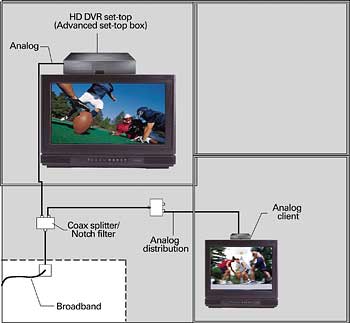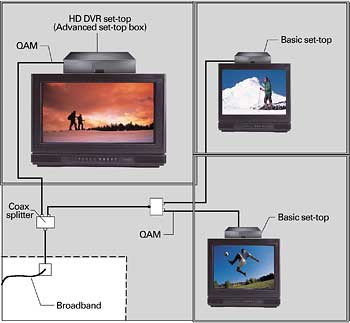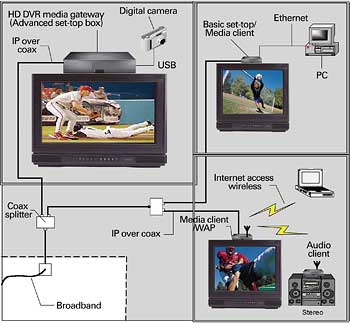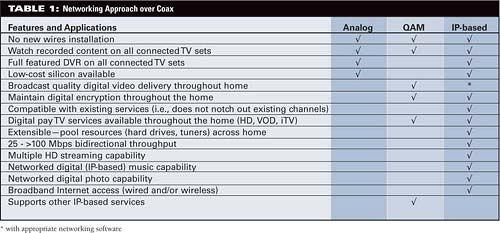Networking the Digital Home
It’s not enough to just get advanced services into the customer premises—customers also want those services distributed throughout the home. There are a number of ways to make it happen, but IP-based networking stands out. A number of recent trends around digital media are culminating in what is being called "the digital home." A primary driver is the pace of digital video recorder (DVR) shipments and the overwhelming desire of a DVR customer to have DVR capabilities on every TV set in the home (1). At the recent NCTA National Show, Scientific Atlanta, Motorola and Digeo all introduced products designed to deliver DVR service to multiple TV sets, although each has a different connectivity approach. These different approaches will be examined later. In addition to DVR, the other building blocks of the digital home include digital music, digital photos, digital telephony, broadband data (home data networking) and other Internet protocol (IP)-based content/applications. The use of each of these other types of content is rapidly increasing. Consumers now have a variety of devices, including TV sets, set-top boxes, computers, stereos, MP-3 players, digital cameras, etc., that can be either places to store content, consume content or both. Making all of this content accessible to all of the various devices in a seamless, interconnected fashion is the central goal of the digital home. Using coax as the backbone The ideal approach to networking the digital home is to require no new wires. Options include using the existing phone lines, power lines, coaxial cable or a wireless approach. The multiple-TV DVR products introduced by Scientific Atlanta, Motorola and Digeo all use coaxial cable as the primary physical layer to interconnect the TV sets in the home. Coax has the following advantages: (1) It is already in place where the TV sets are located (unlike phone line); (2) it is a shielded network without a lot of conflicting traffic (unlike power line); and (3) in general, it can reliably provide enough capacity for video delivery (unlike wireless today). While all of these set-top products use coax, each is using a different protocol/approach on the coax. Digeo’s BMC 9022 built by Motorola is using analog-based distribution, Scientific Atlanta’s 8300 Multi-Room DVR is quadrature amplitude modulation (QAM)-based, and the Motorola 6412 Advanced Home Media Architecture is using IP-based networking (the Multimedia over Coax Alliance, or MoCA, specification). Let’s examine each approach. Analog distribution Analog distribution provides few benefits over currently available digital networking options. While multi-TV DVR using analog distribution may be cheaper in some configurations, the advanced set-top box requires significant resources to support each stream. All user interface graphical overlay information needs to be blended in the advanced set-top, adding significantly to the memory requirements of the box. The current silicon for this analog distribution only powers one additional TV set, so an additional chip is required for each TV set to be connected. Other drawbacks of analog distribution come from the channel properties of using a 6 MHz channel for the secondary TV set. To accommodate the inserted channels, channels must either be set aside or notch filtered at the advanced set-top box. For each additional set in the home, minimally one analog or multiple digital channels are lost. Bandwidth constraints translate to a loss of one analog or many digital channels for each additional TV set supported. Additional bandwidth also is required for one or more modulated back channels. (See Figure 1.) An alternative topology eliminates all signals from the hybrid fiber/coax (HFC) network on the in-home coaxial network. This approach does away with the need for notched or unused channels, but removes all support for existing analog and digital set-tops on the home network. Another concern with the analog solution is that it lacks privacy and makes parental control a challenge. Each stream from the advanced set-top box is sent in the clear over the in-home coax. Anyone in the house can easily see what other members of the family are watching. For example, if the advanced set-top box is remodulating on Ch. 8, any TV set in the home that is tuned to Ch. 8 will see the content. Also, signal integrity issues of analog distribution mean that digital cable customers may notice degradation in picture quality on their secondary TV sets. Perhaps more significant, analog distribution will not support high definition (HD), digital music, data networking or other IP-based services. Analog distribution is not really networking; it is simply connecting a secondary TV set to an advanced set-top. For these reasons, the full vision of the digital home cannot be achieved using analog-based distribution. QAM The desire to reuse legacy set-tops as thin clients has led to an approach that supports Moving Picture Experts Group (MPEG) encapsulation with QAM (downstream) and quadrature phase shift keying (QPSK) (upstream) within the in-home coax to mimic the signaling used over the HFC network. The advantage of this technique is that existing low-end set-tops can be reconfigured to serve as thin-client devices utilizing their in-band and out-of-band network interfaces for communication with an advanced set-top box. This is the approach used by Scientific Atlanta’s Explorer 8300MR DVR set-top box to connect to up to three Explorer 2000 (or higher) set-tops on other TV sets in the home. Drawbacks of adopting this legacy networking approach include the cost of new equipment and the asymmetric communications channel. While the cost of this approach is partially mitigated by the reusability of legacy boxes, the cost of new equipment is driven up by the addition of noncommodity QAM silicon. These QAM chips allow the advanced set-top box to connect to the other low-end set tops, but recreate the inherently asymmetric communications channel supported by the legacy equipment. The lack of a high-speed back channel in the legacy equipment eliminates the possibility of pooling networked resources such as tuners. One result is that the thin-client, low-end set-tops cannot perform some of the fundamental DVR functions such as pausing live TV. Since the tuner that is local to the low-end set top cannot direct its program stream back to the hard drive in the advanced set-top box, the user in front of the low-end set-top cannot pause live TV or use any other of the highly used DVR control functions such as rewind, fast forward and instant-replay while watching live TV. (See Figure 2.) The DVR/electronic program guide (EPG) application itself is not networked, either, in the sense that the client, low-end set-tops cannot schedule programs to record. The user can schedule programs using only the TV set connected directly to the advanced set-top. Customers are likely to be confused about being able to do some functions on the main TV set, but not on the other TV sets in the home. The result will be increased customer support calls. Performance and customer satisfaction issues aside, this approach has significant business ramifications. The proprietary nature of the QAM/QPSK link limits the service providers’ choice of home media networked devices to the same vendor supplying the upstream conditional access (CA) technology. This runs contrary to the efforts of many providers moving toward distribution of customer premises equipment (CPE) through retail consumer electronics channels. Finally, the QAM approach is not suitable for IP traffic and hence cannot support all the IP-based services and applications such as digital music and photos that make up an important part of the digital home. IP-based networking IP-based networking over coax has gained significant traction in the past year. IP-based networking for video is being used today outside of the home in gigabit Ethernet (GigE) implementations for video-on-demand (VOD) distribution systems. In the home, IP-based networking offers increased performance and cost savings that result from the flexibility and extensibility of IP. From a cost standpoint, IP-based networking can utilize the same chip technologies found in common data-networking products and thus leverages massive consumer and commercial volumes to provide a low-cost solution. Several networking options are available today that deliver IP-based networking over coax, including HPNA-over-coax, 802.11g-over-coax and the MoCA approach. MoCA was formed in January 2004 "to develop and promote specifications for the transport of digital entertainment and information content over in-home coaxial cable." MoCA is working on a technology that promises enough capacity for multiple HD streams through the home along with music, data and other simultaneous streams. Motorola has chosen MoCA to power its Home Media Architecture offering. Performance advantages derive from both the multi-use nature of IP and the rapid evolution of IP networking technologies. The use of IP means that the video can be sent in its digital form, including in HD, throughout the home. There is no loss in video quality on the secondary TV sets. This all-digital approach is obviously synergistic with the move to all-digital distribution being mandated by the Federal Communications Commission. The same IP network used to distribute SD and HD quality video signals also can be used to provide a very high bit rate home networking solution for Internet access. Since all new media formats are digital, the IP-based network can support distribution of digital music files in diverse formats, digital photos and even personal camcorder files. That means consumers can download their home movies to the advanced set-top box (server) and then watch them any time they want, anywhere in the home. It also means that emerging premium IP-based audio, photo and video services can be made available throughout the home, increasing the total revenue pool. (See Figure 3.) Because of the bidirectional nature of the IP-networking approach, the resources across the networked set-top boxes all can be pooled. For example, the tuner in a basic set-top can direct its program stream across the coax network to the hard drive in a DVR set-top box, then back to the TV set connected to the basic set-top. As a result, the user can control the live TV stream, including pause, rewind, instant replay, etc. on the `client’ TV sets just as on the primary TV set. This means that a home with one dual-tuner DVR set-top box and two networked basic set-tops has a total of four tuners that are pooled and usable throughout the home. This is then a true networked environment, not the point-to-point connected methods used in the analog and QAM approaches. Also, all the same features are available on all TV sets, so users can schedule a recording from anywhere. This consistency of experience and capabilities throughout the home will drive better customer satisfaction and fewer support calls than any of the nonIP-based methods. In addition to the significant bandwidth, digital quality video and audio, and extension to IP-based media, this approach offers the flexibility to use the coax as the network backbone in the home, then attach additional access points to the coax nodes, or the clients, for wired or wireless networking to computers and other IP-based devices throughout the home. This hybrid wired/wireless approach is the ideal method to network the various devices in the home and securely deliver digital quality video and audio throughout the home. 1. A recent study of DVR customers by C-Cubed reported that more than 70 percent of respondents strongly agreed with the statement, "I want DVR on all my televisions." DVR Monitor Report Wave IV, August 2003. Patrick Donovan is vice president of product management at Ucentric Systems. Reach him at pdonovan@ucentric.com. Figure 1  Figure 2
Figure 2  Figure 3
Figure 3  Table 1
Table 1 